Synthesis and Characterization of Complex Nanostructured Thin Films Based on Titanium for Industrial Applications
Abstract
1. Introduction
2. Experiment Details
2.1. Synthesis of Ti-Based Nanocomposite Films
2.2. Characterization Methods
3. Results and Discussion
3.1. Microscopy Techniques
3.1.1. Atomic Force Microscopy (AFM)
3.1.2. Scanning Electron Microscopy (SEM)
3.1.3. Transmission Electron Microscopy (TEM)
3.2. X-ray Diffraction (XRD) Investigations
3.3. SANS Investigations
3.3.1. 0.015 Å−1 ≤ Q ≤ 0.055 Å−1
3.3.2. 0.06 Å−1 ≤ Q ≤ 0.4 Å−1
4. Conclusions
Author Contributions
Funding
Conflicts of Interest
References
- Kim, H.S.; Yoo, S.J.; Ahn, J.W.; Kim, D.H.; Kim, W.J. Ultrafine grained titanium sheets with high strength and high corrosion resistance. Mater. Sci. Eng. A 2011, 528, 8479–8485. [Google Scholar] [CrossRef]
- Hossein-Babaei, F.; Rahbarpour, S. Titanium and silver contacts on thermally oxidized titanium chip: Electrical and gas sensing properties. Solid State Electron. 2011, 56, 185–190. [Google Scholar] [CrossRef]
- Song, D.-H.; Uhm, S.-H.; Lee, S.-B.; Han, J.-G.; Kim, K.-N. Antimicrobial silver-containing titanium oxide nanocomposite coatings by a reactive magnetron sputtering. Thin Solid Films 2011, 519, 7079–7085. [Google Scholar] [CrossRef]
- Lopes, C.; Gonçalves, C.; Borges, J.; Polcar, T.; Rodrigues, M.S.; Barradas, N.P.; Alves, E.; Le Bourhis, E.; Couto, F.M.; Macedo, F.; et al. Evolution of the functional properties of titanium–silver thin films for biomedical applications: Influence of in-vacuum annealing. Surf. Coat. Technol. 2015, 261, 262–271. [Google Scholar] [CrossRef]
- Guo, C.; Chen, J.; Zhou, J.; Zhao, J.; Wang, L.; Yu, Y.; Zhou, H. Microstructure and tribological properties of TiAg intermetallic compound coating. Appl. Surf. Sci. 2011, 257, 10692–10698. [Google Scholar] [CrossRef]
- Damm, C.; Israel, G. Photoelectric properties and photocatalytic activity of silver-coated titanium dioxides. Dyes Pigment. 2007, 75, 612–618. [Google Scholar] [CrossRef]
- Wang, Z.; Cai, X.; Chen, Q.; Chu, P.K. Effects of Ti transition layer on stability of silver/titanium dioxide multilayered structure. Thin Solid Films 2007, 515, 3146–3150. [Google Scholar] [CrossRef]
- Bai, W.Q.; Li, L.L.; Wang, X.L.; He, F.F.; Liu, D.G.; Jin, G.; Tu, J.P. Effects of Ti content on microstructure, mechanical and tribological properties of Ti-doped amorphous carbon multilayer films. Surf. Coat. Technol. 2015, 266, 70–78. [Google Scholar] [CrossRef]
- Caschera, D.; Federici, F.; Pandolfi, L.; Kaciulis, S.; Sebastiani, M.; Bemporad, E.; Padeletti, G. Effect of composition on mechanical behavior of diamond-like carbon coatings modified with titanium. Thin Solid Films 2011, 519, 3061–3067. [Google Scholar] [CrossRef]
- Lee, J.G.; Hong, S.J.; Lee, M.K.; Rhee, C.K. High strength bonding of titanium to stainless steel using an Ag interlayer. J. Nucl. Mater. 2009, 395, 145–149. [Google Scholar] [CrossRef]
- Yang, C.; Jiang, B.; Liu, Z.; Feng, L.; Hao, J. Nanocrystalline titanium films deposited via thermal-emission-enhanced magnetron sputtering. Thin Solid Films 2015, 597, 117–124. [Google Scholar] [CrossRef]
- Vladoiu, R.; Ciupina, V.; Mandes, A.; Dinca, V.; Prodan, M.; Musa, G. Growth and characteristics of tantalum oxide thin films deposited using thermionic vacuum arc technology. J. Appl. Phys. 2010, 108, 093301. [Google Scholar] [CrossRef]
- Lungu, C.P.; Mustata, I.; Musa, G.; Lungu, A.M.; Brinza, O.; Moldovan, C.; Rotaru, C.; Iosub, R.; Sava, F.; Popescu, M.; et al. Unstressed carbon-metal films deposited by thermionic vacuum arc method. J. Optoelectron. Adv. Mater. 2006, 8, 74–77. [Google Scholar]
- Ciupina, V.; Vladoiu, R.; Lungu, C.P.; Dinca, V.; Contulov, M.; Mandes, A.; Popov, P.; Prodan, G. Investigation of the SiC thin films synthetized by Thermionic Vacuum Arc method (TVA). Eur. Phys. J. D 2012, 66, 99. [Google Scholar] [CrossRef]
- Vladoiu, R.; Dinca, V.; Musa, G. Surface energy evaluation of unhydrogenated DLC thin film deposited by thermionic vacuum arc (TVA) method. Eur. Phys. J. D 2009, 54, 433–437. [Google Scholar] [CrossRef]
- Musa, G.; Vladoiu, R.; Ciupina, V.; Janick, J. Raman spectra of carbon thin films. J. Optoelectron. Adv. Mater. 2006, 8, 621–623. [Google Scholar]
- Mandes, A.; Vladoiu, R.; Dinca, V.; Prodan, G. Binary C-Ag Plasma Breakdown and Structural Characterization of the deposited thin films by Thermionic Vacuum Arc (TVA) method. IEEE Trans. Plasma Sci. 2014, 42, 2806–2807. [Google Scholar] [CrossRef]
- Musa, G.; Vladoiu, R.; Ciupina, V.; Lungu, C.; Mustata, I.; Pat, S.; Akan, T.; Ekem, N. Characteristics of boron thin films obtained by TVA technology. J. Optoelectron. Adv. Mater. 2006, 8, 617–620. [Google Scholar]
- Vladoiu, R.; Mandes, A.; Dinca-Balan, V.; Prodan, G.; Kudrna, P.; Tichý, M. Magnesium plasma diagnostics by heated probe and characterization of the Mg thin films deposited by thermionic vacuum arc technology. Plasma Sources Sci. Technol. 2015, 24, 035008. [Google Scholar] [CrossRef]
- Teodorescu, V.S.; Blanchin, M.-G. Fast and Simple Specimen Preparation for TEM Studies of Oxide Films Deposited on Silicon Wafers. Microsc. Microanal. 2009, 15, 15–19. [Google Scholar] [CrossRef]
- Patterson, A.L. The Scherrer Formula for X-ray Particle Size Determination. Phys. Rev. 1939, 56, 978. [Google Scholar] [CrossRef]
- Kuklin, A.I.; Islamov, A.K.; Kovalev, Y.S.; Utrobin, P.; Gordely, V.I. Optimization two-detector system small-angle neutron spectrometer YuMO for nanoobject investigation. J. Surf. Investig. X ray Synchrotron Neutron Tech. 2006, 6, 73–84. [Google Scholar]
- Kirilov, A.S.; Litvinenko, E.I.; Astakhova, N.V.; Murashkevich, S.M.; Petukhova, T.B.; Yudin, V.E.; Gordelii, V.I.; Islamov, A.K.; Kuklin, A.I. Evolution of the SONIX Software Package for the YuMO Spectrometer at the IBR-2 Reactor. Instrum. Exp. Tech. 2004, 47, 334–335. [Google Scholar] [CrossRef]
- Langford, J.I. The accuracy of cell dimensions determined by Cohen’s method of least squares and the systematic indexing of powder data. J. Appl. Cryst. 1973, 6, 190–196. [Google Scholar] [CrossRef]
- Christensen, A.N. The Temperature Factor Parameters of Some Transition Metal Carbides and Nitrides by Single Crystal X-ray and Neutron Diffraction. Acta Chem. Scand. 1978, 32, 89–90. [Google Scholar] [CrossRef]
- Nelson, J.B.; Riley, D.P. An Experimental Investigation of Extrapolation Methods in the Derivation of Accurate Unit-Cell Dimensions of Crystals. Proc. Phys. Soc. 1945, 57, 160–176. [Google Scholar] [CrossRef]
- Wyckoff, R.W.G. Crystal Structures; WWW-MINCRYST, SILVER-4219; Interscience Publishers: New York, NY, USA, 1963; pp. 7–10. [Google Scholar]
- Wyckoff, R.W.G. Crystal Structures; WWW-MINCRYST, SILICON-4219; Interscience Publishers: New York, NY, USA, 1963; pp. 26–27. [Google Scholar]
- Wyckoff, R.W.G. Crystal Structures; WWW-MINCRYST, TITANIUM-4770; Interscience Publishers: New York, NY, USA, 1963; pp. 9–11. [Google Scholar]
- Zou, X.D.; Sukharev, Y.; Hovmöller, S. Quantitative electron diffraction—New features in the program system ELD. Ultramicroscopy 1993, 52, 436–444. [Google Scholar] [CrossRef]
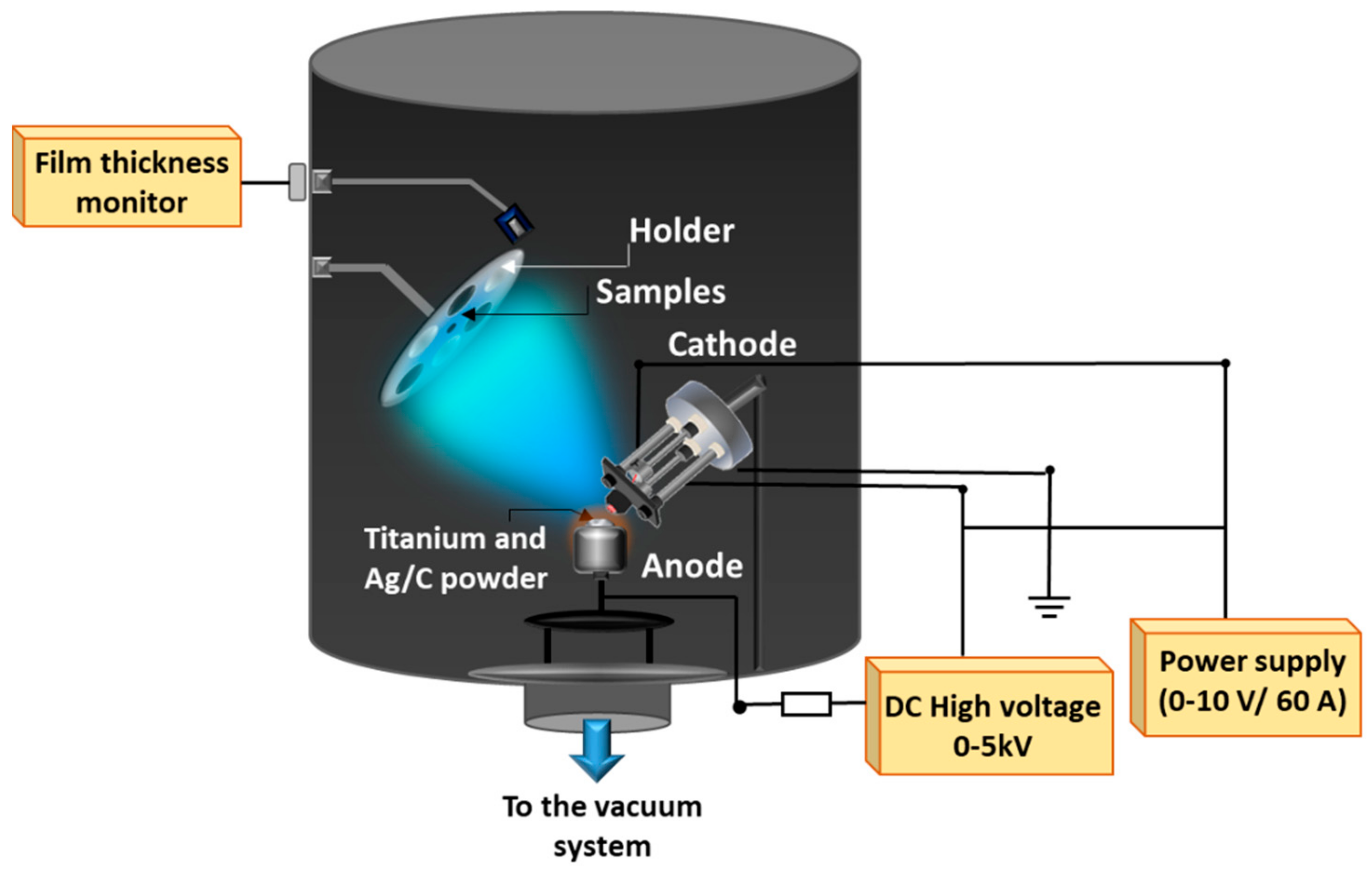
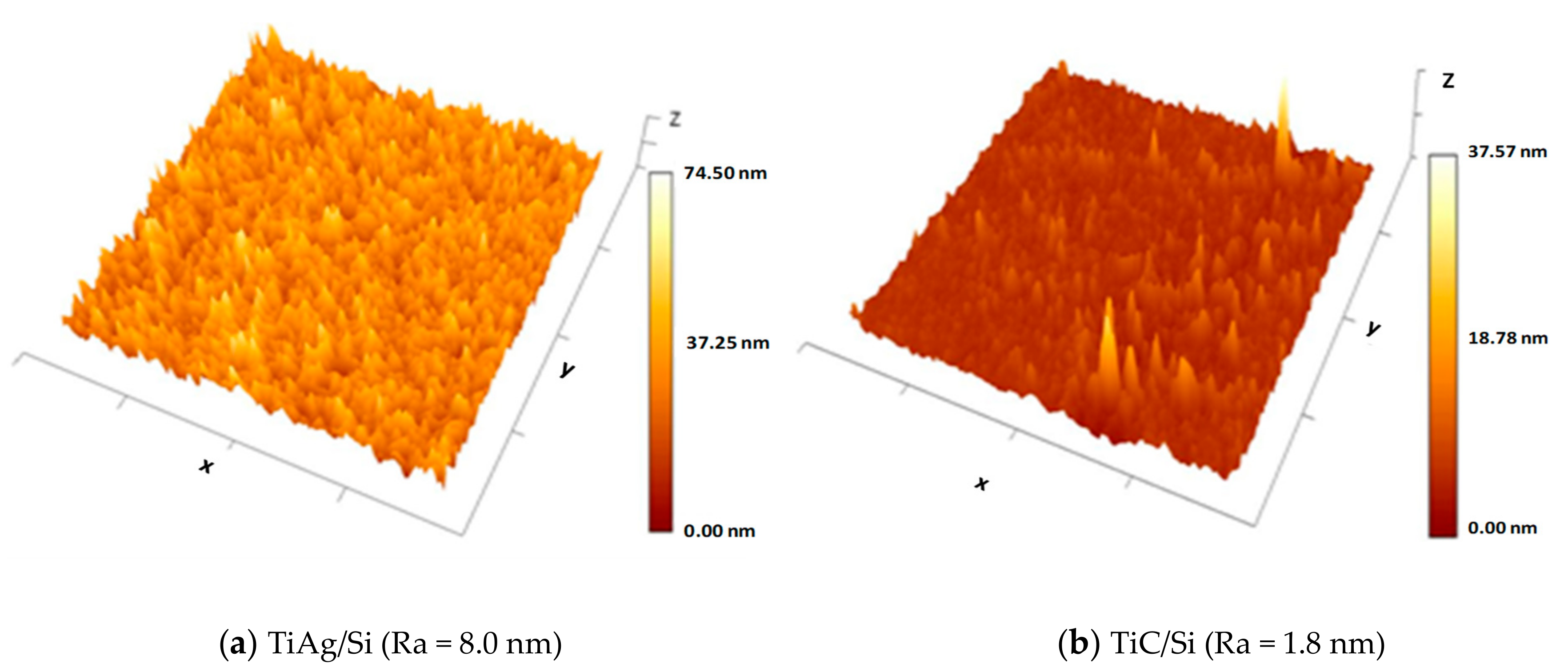
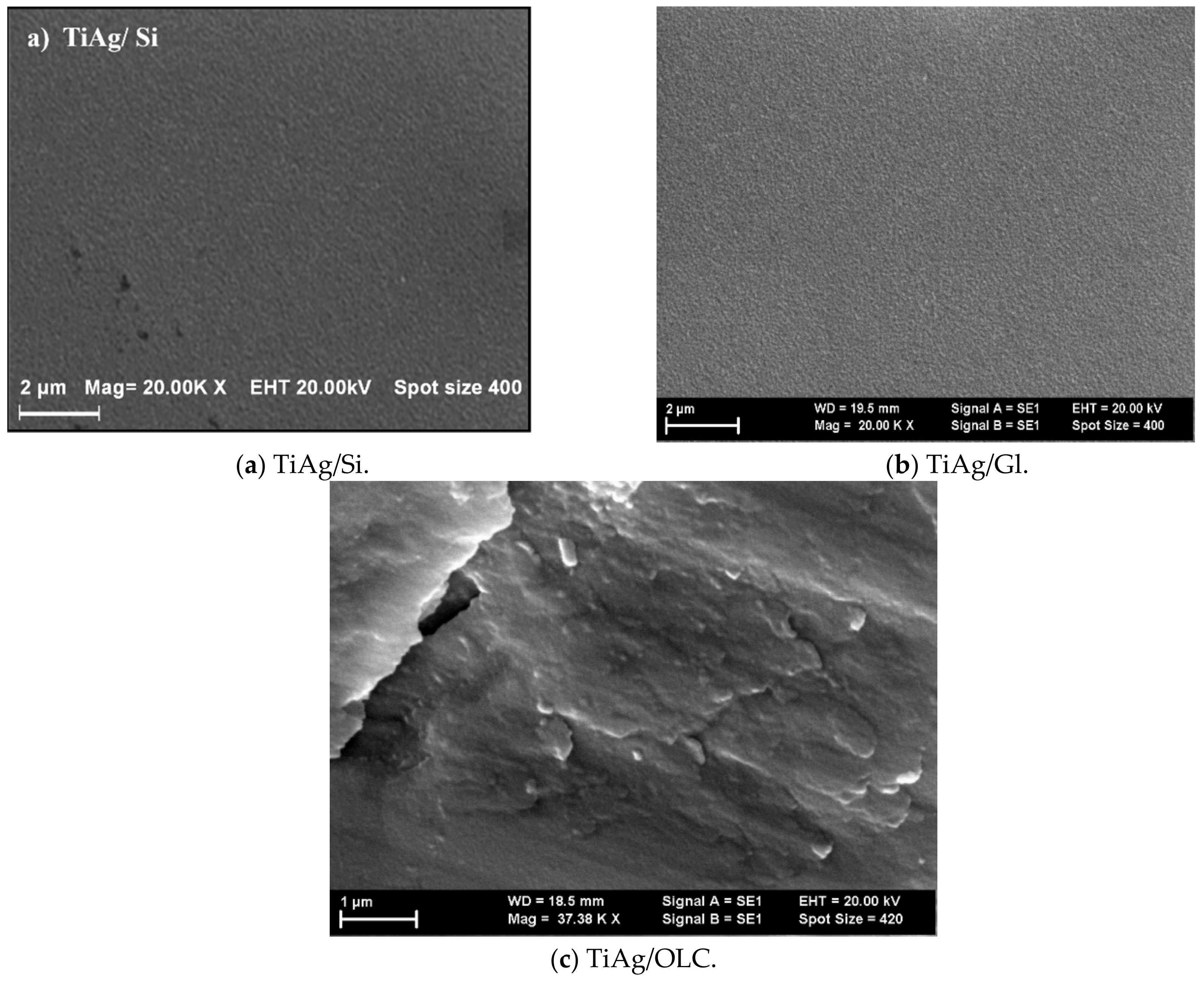
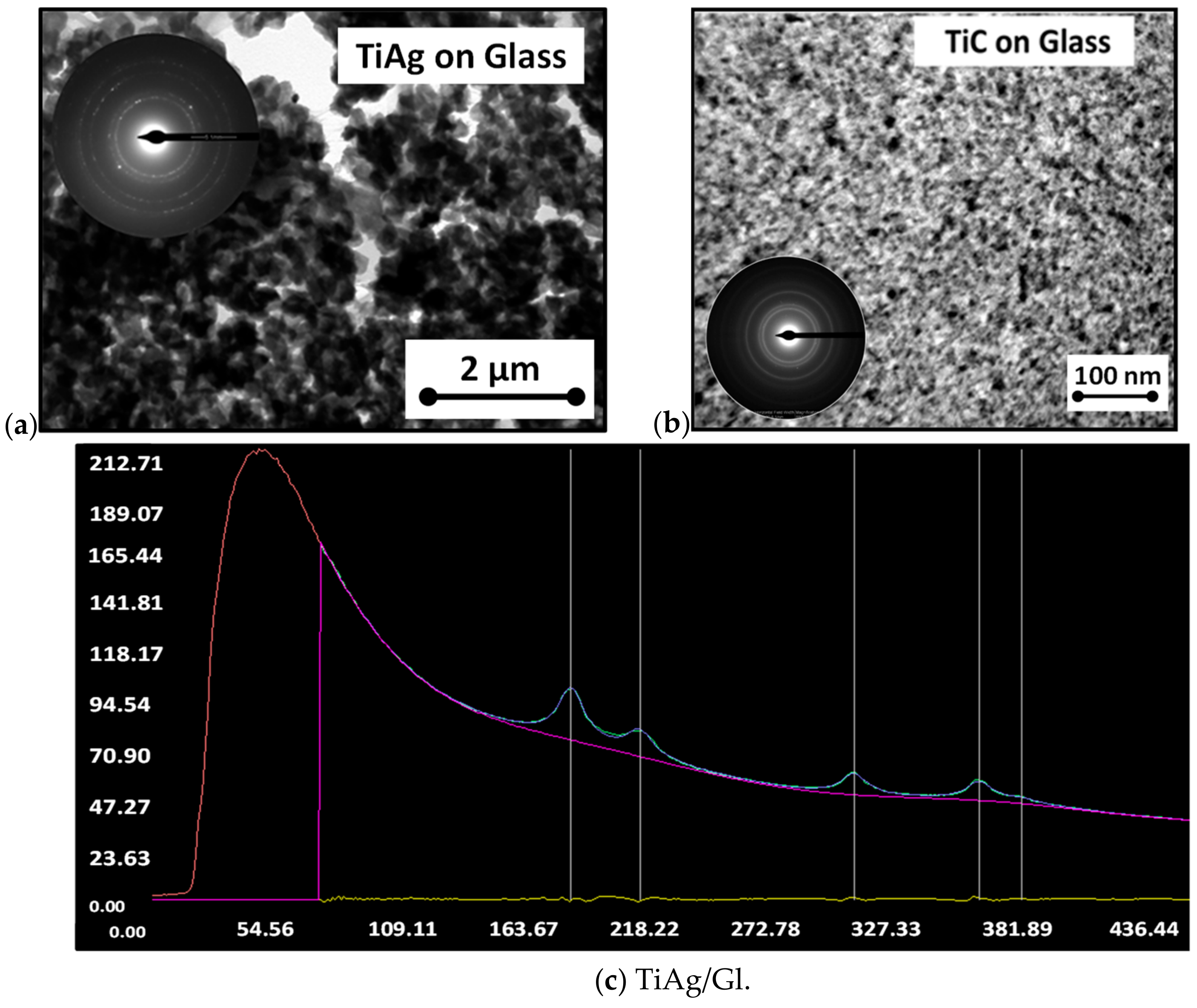
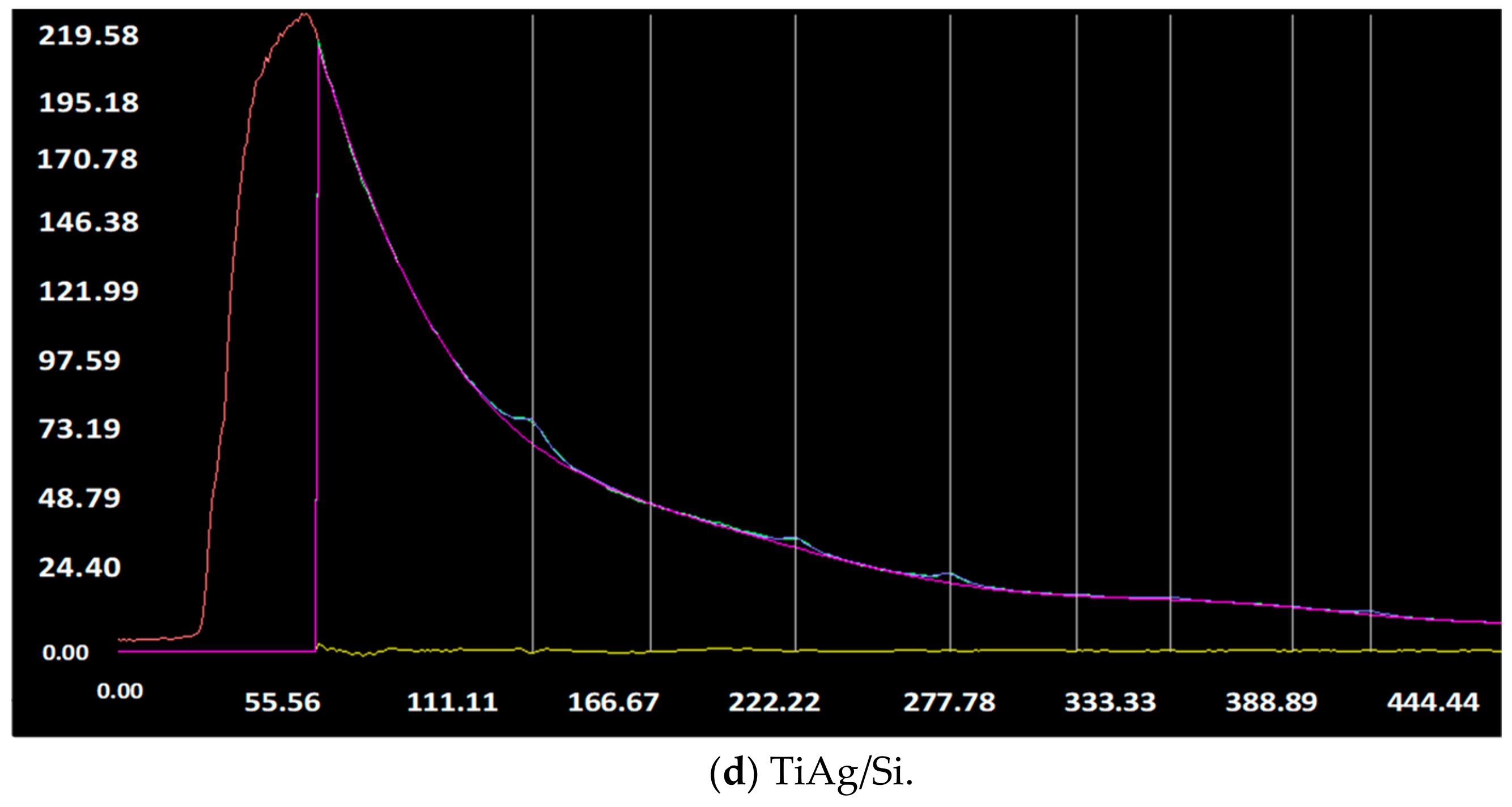
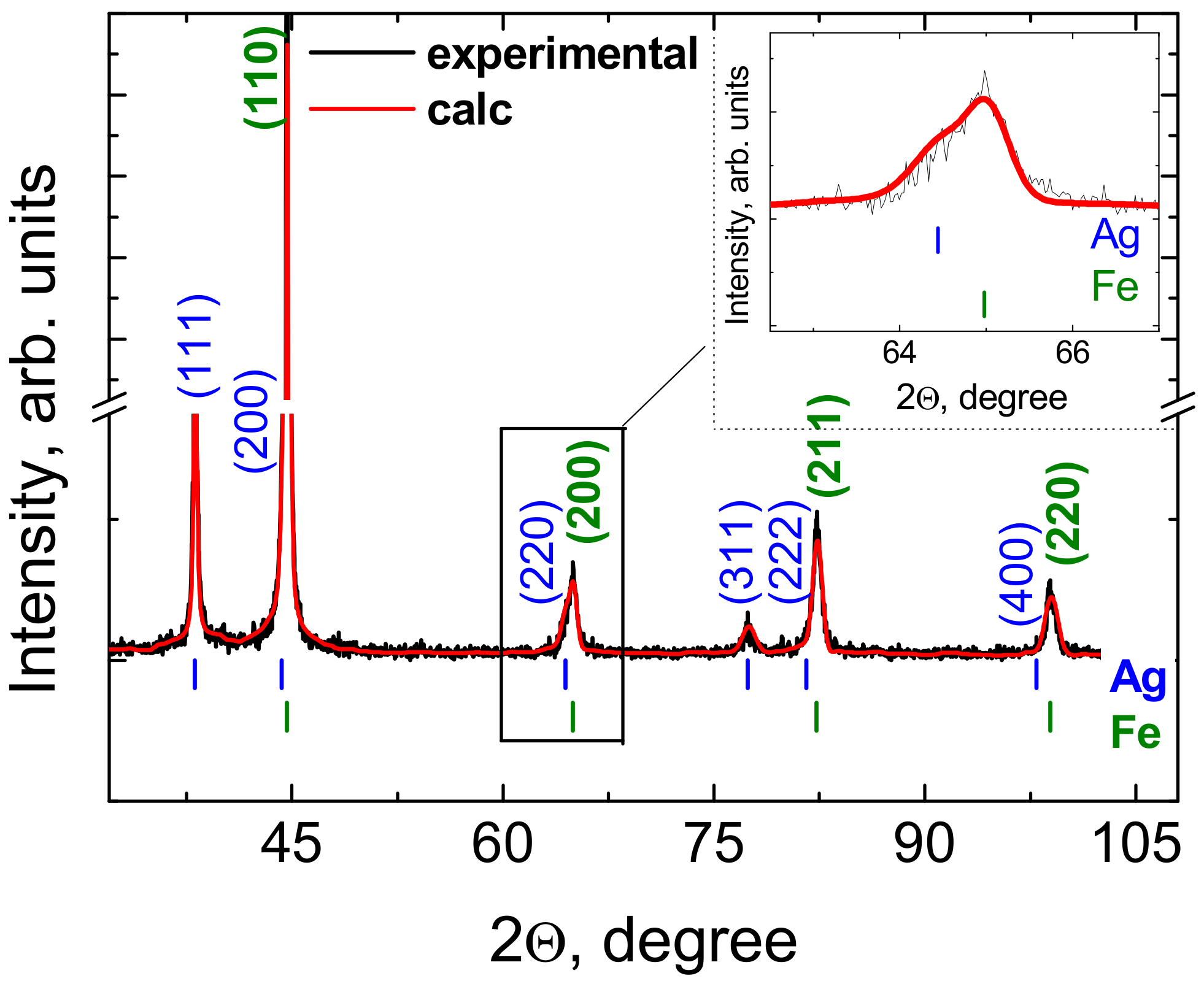
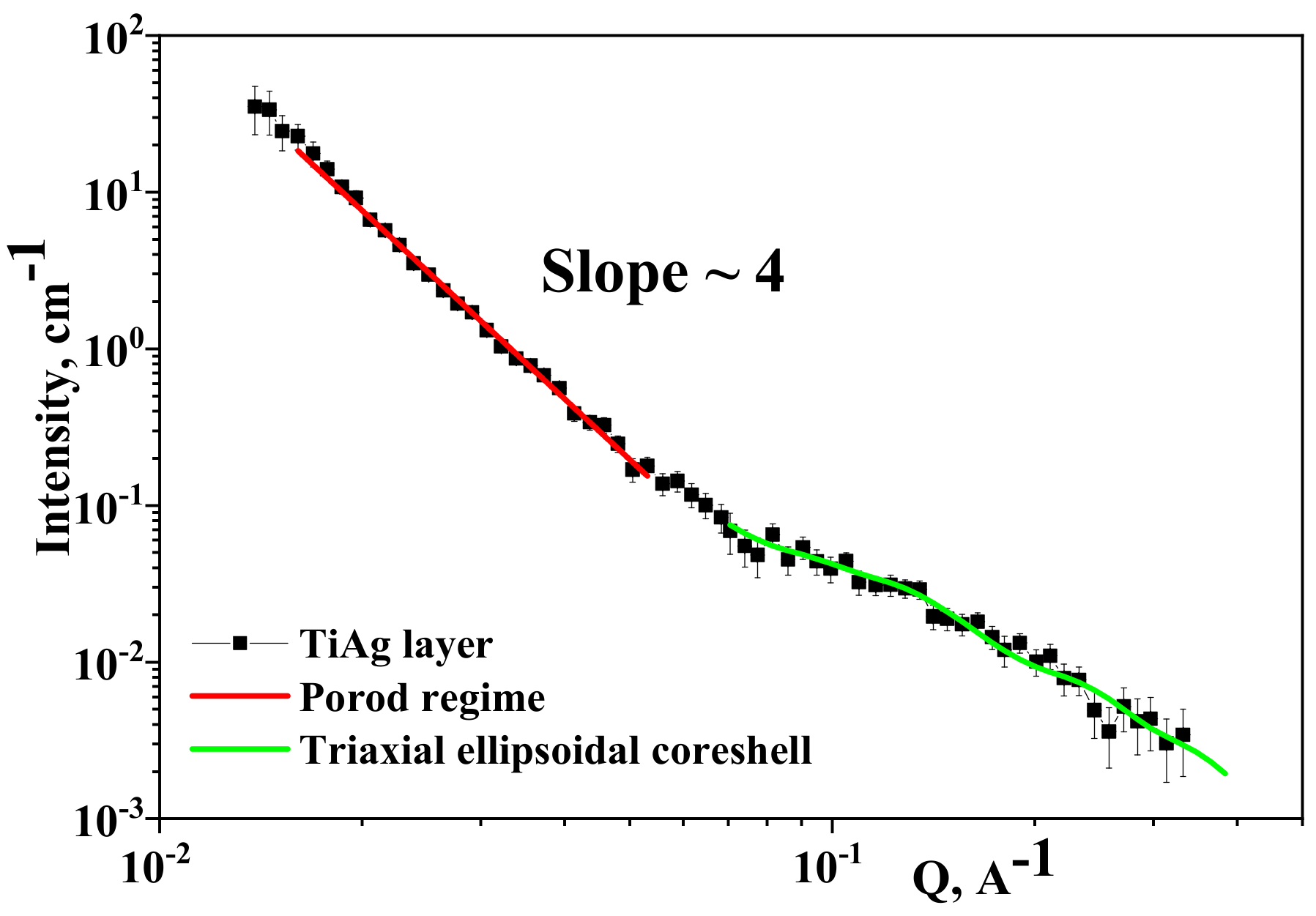
| Parameters | Ti–Ag | Ti–C |
|---|---|---|
| Base pressure pB (Pa) | 4 × 10−5 | 7 × 10−5 |
| Working pressure pw (Pa) | 6 × 10−4 | 7 × 10−4 |
| Substrates | Si, glass, OLC | Glass |
| Distance dA-C (m) | 5 × 10−3 | |
| Distance dA-S (m) | 6 × 10−2 | |
| Intensity current on filament IF (A) | 47 | 48 |
| Input arc power P (kW) | 1.05 | 1.37 |
| Film thickness t (nm) | 120 | 170 |
| Rate of deposition r (nm/s) | 3.5 | 2.5 |
| Peak No. | Distance (nm) | hkl | Distance (nm) (TiC) |
|---|---|---|---|
| 1 | 0.24764 | 111 | 0.249877 |
| 2 | 0.21596 | 200 | 0.216400 |
| 3 | 0.15223 | 220 | 0.153018 |
| 4 | 0.12968 | 113 | 0.130494 |
| 5 | 0.12424 | 222 | 0.124939 |
| No. | 2θ (degr.) | dhkl (Å) | hkl | Rel. Int. (%) | Full Width at Half-Maximum (FWHM, °2θ) | Ref. ICDD PDF No. |
|---|---|---|---|---|---|---|
| 1 | 38.09 | 2.3610 | (111) | 26.8 | 0.270 | 01-071-3762 |
| 2 | 44.28 | 2.0440 | (200) | 6.4 | 0.391 | 01-071-3762 |
| 3 | 44.62 | 2.0291 | (110) | 100.0 | 0.331 | 01-080-3816 |
| 4 | 64.44 | 1.4448 | (220) | 3.6 | 0.782 | 01-071-3762 |
| 5 | 64.98 | 1.4341 | (200) | 4.8 | 0.527 | 01-080-3816 |
| 6 | 77.41 | 1.2319 | (311) | 2.2 | 1.069 | 01-071-3762 |
| 7 | 81.56 | 1.1794 | (222) | 0.8 | 1.172 | 01-071-3762 |
| 8 | 82.29 | 1.1707 | (211) | 9.3 | 0.733 | 01-080-3816 |
| 9 | 97.93 | 1.0212 | (400) | 0.3 | 1.646 | 01-071-3762 |
| 10 | 98.91 | 1.0137 | (220) | 4.6 | 0.989 | 01-080-3816 |
| Model | Triaxial Ellipsoidal Core-Shell (nm) |
|---|---|
| Dimensions | a = 15.7 ± 0.1 |
| b = 14.1 ± 0.1 | |
| c = 6.5 ± 0.1 | |
| t = 4.3 ± 0.1 |
© 2020 by the authors. Licensee MDPI, Basel, Switzerland. This article is an open access article distributed under the terms and conditions of the Creative Commons Attribution (CC BY) license (http://creativecommons.org/licenses/by/4.0/).
Share and Cite
Vladoiu, R.; Mandes, A.; Dinca, V.; Balasoiu, M.; Soloviov, D.; Turchenko, V. Synthesis and Characterization of Complex Nanostructured Thin Films Based on Titanium for Industrial Applications. Materials 2020, 13, 399. https://doi.org/10.3390/ma13020399
Vladoiu R, Mandes A, Dinca V, Balasoiu M, Soloviov D, Turchenko V. Synthesis and Characterization of Complex Nanostructured Thin Films Based on Titanium for Industrial Applications. Materials. 2020; 13(2):399. https://doi.org/10.3390/ma13020399
Chicago/Turabian StyleVladoiu, Rodica, Aurelia Mandes, Virginia Dinca, Maria Balasoiu, Dmytro Soloviov, and Vitalii Turchenko. 2020. "Synthesis and Characterization of Complex Nanostructured Thin Films Based on Titanium for Industrial Applications" Materials 13, no. 2: 399. https://doi.org/10.3390/ma13020399
APA StyleVladoiu, R., Mandes, A., Dinca, V., Balasoiu, M., Soloviov, D., & Turchenko, V. (2020). Synthesis and Characterization of Complex Nanostructured Thin Films Based on Titanium for Industrial Applications. Materials, 13(2), 399. https://doi.org/10.3390/ma13020399





